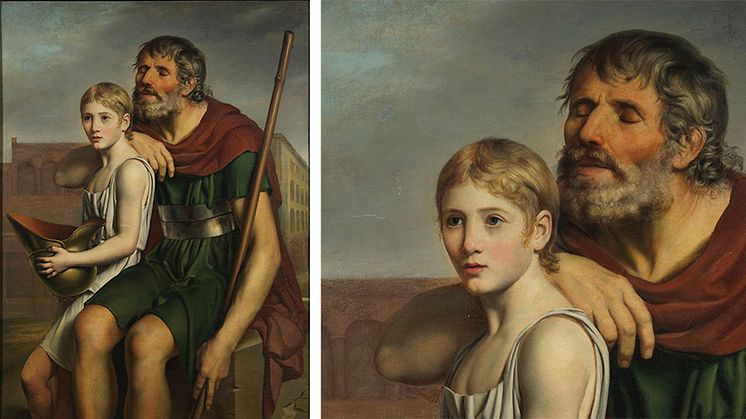
Press release -
Nationalmuseum has acquired a key work in Swedish Neoclassicism
Nationalmuseum has acquired a painting by Per Krafft the Younger (1777-1863) depicting the blind former general Belisarius. This painting ought to be regarded as one of the most prominent Swedish works executed in the French Neoclassical style.
In 1796, at the age of nineteen, Per Krafft the Younger was awarded a travel scholarship by the Royal Swedish Academy of Fine Arts, in part because Jonas Åkerström (1759–1795), who had used the scholarship to spend time in Rome, had suddenly died the year before at the early age of 36. Krafft went to Paris where as the only Swede he spent three years studying under Jacques-Louis David (1748–1825). David had a large number of pupils, and his teaching, which in those days was held at the Louvre, laid emphasis on painting and drawing technique, modelling and nature studies in order to depict only the ideal subject matter: themes from antiquity.
David’s influence is evident in Krafft’s painting, which ought to be regarded as one of the most prominent Swedish works executed in the French Neoclassical style. It shows the strict lines of classical architecture in the background and a sculptural approach to the figure drawing. The palette is also a reminder of David’s work, with fine contrasts between their clothing – white and green and red – worn by Belisarius and the boy, their skin tone and the shiny surface of the reflective metal on the belt and helmet. The figures almost stand out in relief against the light brown, yellow and blue-grey tones of the background. The work was executed in 1799 and sent together with three other paintings – Phrygian lyre player meditating, Paris and Love – to Stockholm for exhibiting at the Royal Academy of Fine Arts in 1801.
The motif showing the successful Byzantine general Belisarius who was reduced to beggar status proved popular in the latter part of the 18th century as a result of the novel Bélisaire by Jean-François Marmontel (1723–1799) which was published in 1767. As a punishment for the general who was suspected of having conspired against him, the Byzantine emperor Justinian I is alleged to have put out Belisarius’ eyes, after which Belisarius was forced to beg by the gates of Rome. This choice of motif gave Krafft the opportunity to direct criticism in allegorical form at the tyrannical rulers of his day. Nor is it altogether surprising that Krafft’s teacher, the Republican David, had used the motif in a famous painting from 1781, now on display in the Palais des Beaux-Arts in Lille. A further famous example was executed by another of David’s pupils, François-Pascal-Simon Gérard (1770–1837), now on display in the J. Paul Getty Museum in Los Angeles.
Krafft emphasises the pathos of his subject in the sober mood that permeates his work in general and in the detail in particular, such as the way the old soldier uses his helmet to collect the alms received. Per Krafft the Younger enjoyed a long life. He was appointed court painter and professor at the Royal Academy of Fine Arts. During his career he was to become primarily a portrait painter.
Nationalmuseum receives no state funding for art acquisitions; rather, the collections benefit from donations and funding from private trusts and foundations. This acquisition has been made possible by a generous donation from the Hedda & N.D. Qvist Memorial Fund.
Inventory number: NM 7468
Further information
Daniel Prytz, Curator, daniel.prytz@nationalmuseum.se, 08-519 543 06
Mattias Robertson, Press Officer, press@nationalmuseum.se, 0767-23 46 32
Related links
Categories
Nationalmuseum is Sweden’s museum of art and design. The collections comprise older paintings, sculpture, drawings and graphic art, and applied art and design up to the present day. The museum building is currently under renovation and scheduled to open again October 13, 2018. In the meantime, the museum will continue its activities through collaborations both in Sweden and abroad. Nationalmuseum has partnerships with Svenska Dagbladet and the Grand Hôtel Stockholm.

